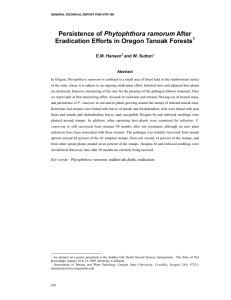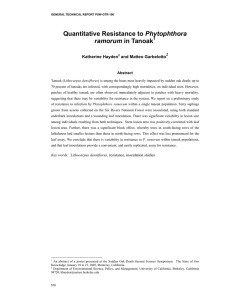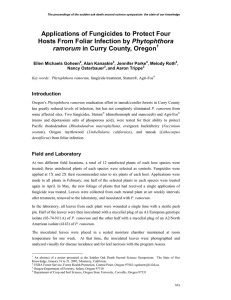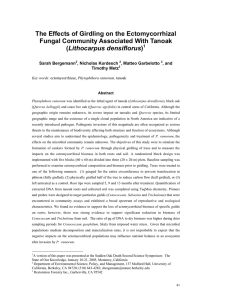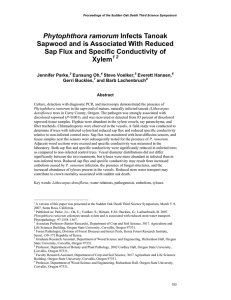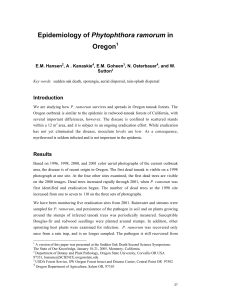Vegetation Response Following Treatments in Southwest Oregon Forests Phytophthora ramorum
advertisement
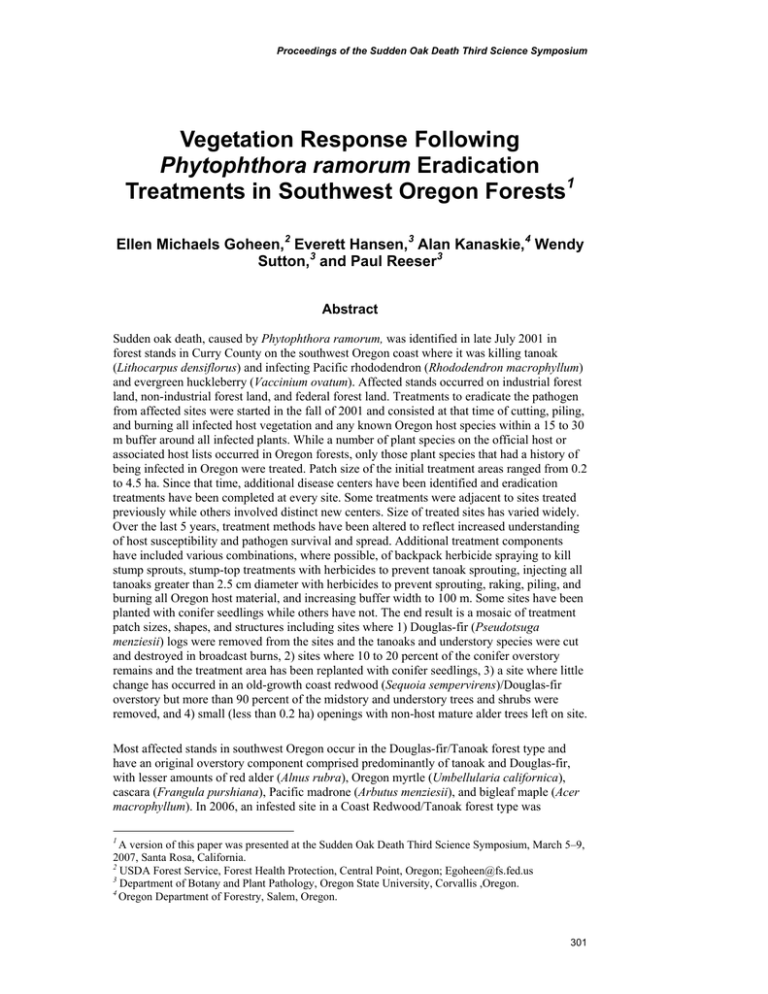
Proceedings of the Sudden Oak Death Third Science Symposium Vegetation Response Following Phytophthora ramorum Eradication Treatments in Southwest Oregon Forests1 Ellen Michaels Goheen,2 Everett Hansen,3 Alan Kanaskie,4 Wendy Sutton,3 and Paul Reeser3 Abstract Sudden oak death, caused by Phytophthora ramorum, was identified in late July 2001 in forest stands in Curry County on the southwest Oregon coast where it was killing tanoak (Lithocarpus densiflorus) and infecting Pacific rhododendron (Rhododendron macrophyllum) and evergreen huckleberry (Vaccinium ovatum). Affected stands occurred on industrial forest land, non-industrial forest land, and federal forest land. Treatments to eradicate the pathogen from affected sites were started in the fall of 2001 and consisted at that time of cutting, piling, and burning all infected host vegetation and any known Oregon host species within a 15 to 30 m buffer around all infected plants. While a number of plant species on the official host or associated host lists occurred in Oregon forests, only those plant species that had a history of being infected in Oregon were treated. Patch size of the initial treatment areas ranged from 0.2 to 4.5 ha. Since that time, additional disease centers have been identified and eradication treatments have been completed at every site. Some treatments were adjacent to sites treated previously while others involved distinct new centers. Size of treated sites has varied widely. Over the last 5 years, treatment methods have been altered to reflect increased understanding of host susceptibility and pathogen survival and spread. Additional treatment components have included various combinations, where possible, of backpack herbicide spraying to kill stump sprouts, stump-top treatments with herbicides to prevent tanoak sprouting, injecting all tanoaks greater than 2.5 cm diameter with herbicides to prevent sprouting, raking, piling, and burning all Oregon host material, and increasing buffer width to 100 m. Some sites have been planted with conifer seedlings while others have not. The end result is a mosaic of treatment patch sizes, shapes, and structures including sites where 1) Douglas-fir (Pseudotsuga menziesii) logs were removed from the sites and the tanoaks and understory species were cut and destroyed in broadcast burns, 2) sites where 10 to 20 percent of the conifer overstory remains and the treatment area has been replanted with conifer seedlings, 3) a site where little change has occurred in an old-growth coast redwood (Sequoia sempervirens)/Douglas-fir overstory but more than 90 percent of the midstory and understory trees and shrubs were removed, and 4) small (less than 0.2 ha) openings with non-host mature alder trees left on site. Most affected stands in southwest Oregon occur in the Douglas-fir/Tanoak forest type and have an original overstory component comprised predominantly of tanoak and Douglas-fir, with lesser amounts of red alder (Alnus rubra), Oregon myrtle (Umbellularia californica), cascara (Frangula purshiana), Pacific madrone (Arbutus menziesii), and bigleaf maple (Acer macrophyllum). In 2006, an infested site in a Coast Redwood/Tanoak forest type was 1 A version of this paper was presented at the Sudden Oak Death Third Science Symposium, March 5–9, 2007, Santa Rosa, California. 2 USDA Forest Service, Forest Health Protection, Central Point, Oregon; Egoheen@fs.fed.us 3 Department of Botany and Plant Pathology, Oregon State University, Corvallis ,Oregon. 4 Oregon Department of Forestry, Salem, Oregon. 301 GENERAL TECHNICAL REPORT PSW-GTR-214 confirmed and subsequently treated. On that site, Douglas-fir and coast redwood make up the overstory and tanoak was the predominant component of the midstory prior to treatment. The understory species mix in both forest types treated includes substantial amounts of tanoak, Pacific rhododendron, Oregon myrtle, and evergreen huckleberry, as well as a number of other shrub and herb species. Many of the species in both the overstory and understory produce prolific stump sprouts following cutting or burning. Treated sites are being monitored for the presence of the pathogen using a variety of techniques including stream-water baiting with tanoak and rhododendron leaves, soil sampling and baiting using pear and leaf baits, and collecting vegetation samples on site and subjecting them to isolation and PCR-based diagnostic tests. While a few of the sites treated initially are now evidently free of the pathogen, on many sites P. ramorum, is still present in the soil or can be baited from streams flowing through treatment areas. There is also a strong interest in monitoring both planted and natural vegetation on these sites. This interest stems from the desire to quantify and qualify how vegetation responds to treatment protocols, how vegetation responds in the presence of the pathogen, and whether the resulting vegetation structure and composition on the sites following treatments is consistent with overall landowner objectives. A series of variable-radius and fixed area plots designed to sample between 5.0 to 7.5 percent of the treated areas were established to describe vegetation condition before and after eradication on a selection of sites. Trees greater than 13 cm dbh were accounted for in variable-radius plots. Trees less than 13 cm dbh were tallied and percent cover of shrub species was estimated on 0.02 ha circular plots. In some cases, pre-eradication conditions were determined from plots just outside treated areas but in similar forest types. Plants on plots and on transects between plots were examined for symptoms of P. ramorum infection. ELISA tests using field diagnostic kits were used to prescreen some symptomatic tissues for Phytophthora species infection. Most suspicious samples were sent to the laboratory at Oregon State University for identification. Vegetation data 5 years after treatment show little change in overall species composition on treated sites, with the obvious exceptions that the overstory tanoak component on treated sites was eliminated in all cases, and on two sites, conifers not present before treatment were planted after treatment. In situations other than industrial forest lands where merchantable Douglas-firs within treated sites were cut and logs were removed to a nearby mill, conifers such as Douglas-fir or coast redwood, or non-host hardwoods such as red alder were left standing on sites. There were substantial changes in the percent cover occupied by understory tanoak, evergreen huckleberry, and Pacific rhododendron after treatment; however, these species were not entirely eliminated on any treated site. Tanoak sprouts were sometimes missed in post-treatment herbicide sprays. Evergreen huckleberry and Pacific rhododendron were not routinely subjected to herbicides and many sprouted back after cutting. Percent cover of sword fern (Polystichum munitum) generally increased after treatments. No samples collected on plots or along transects between plots were found to be infected by P. ramorum. Early eradication prescriptions involved only the cutting and burning of infected and buffer host plants. When resprouting tanoaks and evergreen huckleberry plants on several sites were confirmed to be infected, herbicide treatment to kill stump sprouts was immediately done. In 2003, 3 m-diameter plots on five of the treatment areas were located around 43 stumps resulting from the cutting of known infected trees. Douglas-fir and redwood seedlings were deliberately planted as P. ramorum susceptible baits around each of the stumps on some sites while on others, seedlings planted as a part of post-eradication reforestation were used as bait. Sprouting tanoak, Pacific rhododendron, and evergreen huckleberry were also monitored for infection. These stump-based plots have been revisited and vegetation condition of all host plants on each plot has been reassessed several times since the initial plot installation, with the 302 Proceedings of the Sudden Oak Death Third Science Symposium most recent evaluation done in January 2007. Since the initial identification of infected tanoak and evergreen huckleberry sprouts, no vegetation on these plots, planted or natural, has been found infected. In May 2003 soil samples were collected at the base of the selected stumps and baited for the presence of P. ramorum. Soil sampling at these stumps has continued through the present on most sites. Phytophthora ramorum has been recovered from soil samples periodically since 2003 at the base of selected stumps on three of the sites, was recovered only in the initial sampling on one site, and was never recovered from soil samples on one site (table 1) Table 1—Number of samples where Phytophthora ramorum was baited from soil collected adjacent to stumps of previously infected trees at five eradication treatment sites in Curry County, Oregon Sample date 12/2004 6/2005 1/2007 10 0/7 0/8 0/8 11 0/1 1/4 0/3 18 1/8 3/8 2/8 33 7/16 4/17 8/13 36 Not 0/5 Not sampled sampled * Number of stumps where P. ramorum was recovered from adjacent soil/Total number of stumps sampled at the site Site 5/2003 2/8* 0/5 1/8 3/17 0/5 7/2004 0/8 0/5 0/8 0/5 0/5 Conclusions from monitoring vegetation response to P. ramorum eradication treatments in southwest Oregon 5 years after treatment include the following: • Most components of the native flora found in Douglas-fir/Tanoak and Coast Redwood/Tanoak ecosystems are essentially intact on eradication sites after treatment, excepting tanoak which has been removed from the overstory and midstory of all treated sites. • Openings create conditions apparently unfavorable for P. ramorum. No new infections have been found on host species regenerating or surviving within treated areas. This includes host species in close proximity to known infested stumps or where soil remains infested. • Landowner objectives for growing conifer species are not compromised. Planted Douglas-fir and coast redwood seedlings/saplings associated with known infested stumps and in areas where soil remains infested are healthy. • The structural component of habitat for northern spotted owl in the Coast Redwood/Tanoak site has been temporarily altered due to reductions in the midstory and understory; however, according to local wildlife biologists, conditions appear to be good for foraging. Vegetation monitoring on treated sites will continue. Key words: Phytophthora ramorum, sudden oak death, eradication. 303
